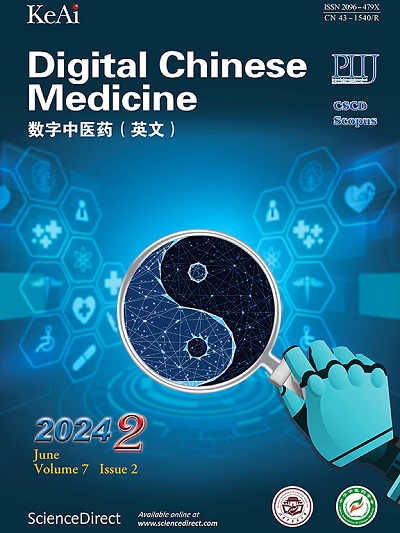Correlation analysis between facial feature-based traditional Chinese medicine inspection of spirit classification and Beck Depression Inventory score
Q3 Medicine
引用次数: 0
Abstract
Objective
To determine the correlation between traditional Chinese medicine (TCM) inspection of spirit classification and the severity grade of depression based on facial features, offering insights for intelligent intergrated TCM and western medicine diagnosis of depression.
Methods
Using the Audio-Visual Emotion Challenge and Workshop (AVEC 2014) public dataset on depression, which conclude 150 interview videos, the samples were classified according to the TCM inspection of spirit classification: Deshen (得神, presence of spirit), Shaoshen (少神, insufficiency of spirit), and Shenluan (神乱, confusion of spirit). Meanwhile, based on Beck Depression Inventory-II (BDI-II) score for the severity grade of depression, the samples were divided into minimal (0 – 13, Q1), mild (14 – 19, Q2), moderate (20 – 28, Q3), and severe (29 – 63, Q4). Sixty-eight landmarks were extracted with a ResNet-50 network, and the feature extracion mode was stadardized. Random forest and support vectior machine (SVM) classifiers were used to predict TCM inspection of spirit classification and the severity grade of depression, respectively. A Chi-square test and Apriori association rule mining were then applied to quantify and explore the relationships.
Results
The analysis revealed a statistically significant and moderately strong association between TCM spirit classification and the severity grade of depression, as confirmed by a Chi-square test (χ2 = 14.04, P = 0.029) with a Cramer’s V effect size of 0.243. Further exploration using association rule mining identified the most compelling rule: “moderate depression (Q3) → Shenluan”. This rule demonstrated a support level of 5%, indicating this specific co-occurrence was present in 5% of the cohort. Crucially, it achieved a high Confidence of 86%, meaning that among patients diagnosed with Q3, 86% exhibited the Shenluan pattern according to TCM assessment. The substantial Lift of 2.37 signifies that the observed likelihood of Shenluan manifesting in Q3 patients is 2.37 times higher than would be expected by chance if these states were independent—compelling evidence of a highly non-random association. Consequently, Shenluan emerges as a distinct and core TCM diagnostic manifestation strongly linked to Q3, forming a clinically significant phenotype within this patient subgroup.
Conclusion
Automated facial analysis can serve as a common lens for TCM and western psychological assessments align in the diagnosis of depression. The inspection of spirit decline trajectory parallels worsening depression, supporting early screening and stratified intervention, and providing a reference for the intelligent assistance of integrated TCM and western medicine in the diagnosis of depression.
基于面相特征的中医精神分类检验与贝克抑郁量表评分的相关分析
目的探讨基于面部特征的中医精神分型检查与抑郁症严重程度的相关性,为抑郁症的中西医结合智能诊断提供依据。方法利用AVEC 2014抑郁症视听情感挑战与研讨会(AVEC 2014)公开数据集(共150个访谈视频),将样本按照精神分类的中医检验进行分类:德神(精神存在)、少神(精神不足)和神乱(精神混乱)。同时,根据贝克抑郁量表- ii (BDI-II)抑郁严重程度评分,将样本分为轻度(0 - 13分,Q1)、轻度(14 - 19分,Q2)、中度(20 - 28分,Q3)和重度(29 - 63分,Q4)。采用ResNet-50网络提取68个地标,并对特征提取模式进行标准化。采用随机森林分类器和支持向量机分类器分别对精神分类和抑郁严重程度进行中医检验预测。然后应用卡方检验和Apriori关联规则挖掘来量化和探索关系。结果经卡方检验(χ2 = 14.04, P = 0.029), Cramer 's V效应值为0.243,中医精神分级与抑郁严重程度有统计学意义,相关性为中强。使用关联规则挖掘的进一步探索确定了最引人注目的规则:“中度抑郁(Q3)→深鸾”。该规则显示了5%的支持水平,表明5%的队列中存在这种特定的共发生。至关重要的是,它达到了86%的高置信度,这意味着在被诊断为Q3的患者中,86%的人根据中医评估表现出神鸾型。2.37的大幅提升表明,如果这些状态是高度非随机关联的独立有力证据,那么观察到的Q3患者出现神鸾的可能性是偶然预期的2.37倍。因此,神鸾成为与Q3密切相关的一种独特而核心的中医诊断表现,在该患者亚群中形成了具有临床意义的表型。结论面部自动分析可作为中医与西医心理评估相结合诊断抑郁症的通用视角。精神衰退轨迹检查与抑郁症加重平行,支持早期筛查和分层干预,为中西医结合诊断抑郁症的智能辅助提供参考。
本文章由计算机程序翻译,如有差异,请以英文原文为准。
求助全文
约1分钟内获得全文
求助全文
来源期刊

Digital Chinese Medicine
Medicine-Complementary and Alternative Medicine
CiteScore
1.80
自引率
0.00%
发文量
126
审稿时长
63 days
期刊介绍:
 求助内容:
求助内容: 应助结果提醒方式:
应助结果提醒方式:


